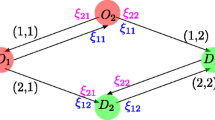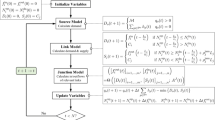Abstract
The notion of dynamic user equilibrium (DUE) and dynamic user optimum (DUO) were still treated interchangeably in the dynamic traffic assignment (DTA) literature until tolerance-based DUO was recently proposed as alternative definitions of DUO. The latter distinguishes DUO from DUE, and the tolerances can be prescribed a priori (i.e. DUO with fixed tolerance) or endogenously (i.e. DUO with variable tolerance). These tolerances reflect the differences in travel costs between used paths of an origin–destination (OD) pair. Since DUE requires zero difference in travel costs between used paths of an OD pair, it can be regarded as DUO with zero tolerance. This paper first compares the three alternative definitions of DUO and discusses their relationships. Secondly, the existence conditions of these DUO solutions are discussed. A key conclusion is that DUO with variable tolerance always exists even when the other two types of DUO solutions may not. The second conclusion is that, when the tolerances are equal to zero, the solution must be a DUE solution. Furthermore, DUE is a special case of DUO with variable tolerance; since the tolerance in the concept of DUO with variable tolerance is an endogenous variable, if a DUE solution exists, an efficient method for solving for DUO with variable tolerance should directly find such a DUE solution. All these are illustrated by means of three examples. Finally, it is acknowledged that the analysis of DUO with variable tolerance in the same rigor as that of DUE is a challenging problem and worthy of further research.

Similar content being viewed by others
References
Arnott R, De Palma A, Lindsey R (1990) Economics of a bottleneck. J Urban Econ 27(1):111–130
Beckmann MJ, McGuire CB, Winsten CB (1956) Studies in the economics of transportation. Yale University Press, New Haven, Connecticut
Carey M, Ge YE (2005) Alternative conditions for a well-behaved travel-time model. Transp Sci 39:417–428
Carey M, Ge YE (2012) Comparison of methods for path inflow reassignment for dynamic user equilibrium. Netw Spat Econ 12(3):337–376
Chiu Y–C, Bottom J, Mahut M, Paz A, Balakrishna R, Waller T and Hicks J (2011) Dynamic traffic assignment: a primer. Transportation Research Circular E-C 153, Transportation research board
Dafermos S, Sparrow FT (1969) The traffic assignment problem for a general network. J Res Natl Bur Stand 73B:91–118
Daganzo CF (1995) The cell transmission model, part II: network traffic. Transp Res B 29:79–93
Friesz TL, Bernstein D, Smith TE, Tobin RL and Wie B-W (1993) A variational inequality formulation of the dynamic network user equilibrium problem. Oper Res 41:179–191
Friesz TL, Kim T, Kwon C, Rigdon MA (2011) Approximate network loading and dual-time-scale dynamic user equilibrium. Transp Res B 45(1):176–207
Ge YE, Zhou X (2012) An alternative definition of dynamic user optimum on signalised road networks. J Adv Transp 46(3):236–253
Ge YE, Zhang S, Szeto WY, Zhang HM and Zhou X (2013) Dynamic user optimal flow under departure time choice and variable tolerances, working paper
Guo X, Liu H (2011) Bounded rationality and irreversible network change. Transp Res B 45(10):1606–1618
Heydecker BG (1986) On the definition of traffic equilibrium. Transp Res B 20(6):435–440
Iryo T (2013) Properties of dynamic user equilibrium solution: existence, uniqueness, stability, and robust solution methodology. Transportmetrica B: Transport Dynamics 1(1):52–67
Jason BN (1991) Dynamic traffic assignment for urban road networks. Transp Res B 25(2–3):143–161
Knight FH (1924) Some fallacies in the interpretation of social cost. Q J Econ 38:582–606
Laih C–H (2004) Effects of the optimal step toll scheme on equilibrium commuter behaviour. Appl Econ 36(1):59–81
Lions J-L (1969) Quelques méthodes de résolution des problèmes aux limites non linéaires. Dunod, Paris
Lo HK, Szeto WY (2002a) A cell-based variational inequality of the dynamic user optimal assignment problem. Transp Res B 36:421–443
Lo HK, Szeto WY (2002b) A cell-based dynamic traffic assignment model: formulation and properties. Math Comput Model 35(7–8):849–865
Mahmassani HS, Chang G-L (1987) On boundedly-rational user equilibrium in transportation systems. Transp Sci 21(2):89–99
Mahmassani HS, Herman R (1984) Dynamic user equilibrium departure time and route choice on idealized traffic arterials. Transp Sci 18(4):362–384
Marcotte P, Patriksson M (2007) Traffic equilibrium. In: Barnhart C, Laporte G (eds) Handbooks in operations research. Manag Sci, Chapter 10, vol 14, pp 623–713
Nagurney A (1993) Network economics: a variational inequality approach. Kluwer Academic Publishers, Norwell
Nie XJ, Zhang HM (2005a) The delay-function-based link models: their properties and computational issues. Transp Res B 39:729–751
Nie XJ, Zhang HM (2005b) A comparative study of some macroscopic link models used in dynamic traffic assignment. Netw Spat Econ 5(1):89–115
Nie Y, Zhang HM (2010) Solving the dynamic user optimal assignment problem considering queue spillback. Netw Spat Econ 10(1):49–71
Papageorgiou M (1990) Dynamic modeling, assignment, and route guidance in traffic networks. Transp Res B 24(6):471–495
Ran B, Boyce DE, LeBlanc LJ (1993) A new class of instantaneous dynamic user-optimal traffic assignment models. Oper Res 41:192–202
Simon HA (1957) A behavioral model of rational choice, in models of man, social and rational: mathematical essays on rational human behavior in a social setting. Wiley, New York
Simon HA (1990) A mechanism for social selection and successful altruism. Science 250(4988):1665–1668
Simon HA (1991) Bounded rationality and organizational learning. Organ Sci 2(1):125–134
Smith MJ (1979) The existence, uniqueness and stability of traffic equilibria. Transp Res B 13:295–304
Smith MJ (1984) Two alternative definitions of traffic equilibrium. Transp Res B 18(1):63–65
Stewart K, Ge YE (2014) Optimising network flows by low-revenue tolling under the principles of dynamic user equilibrium. Eur J Transp Infrastruct Res 14(1):30–45
Szeto WY (2003) Dynamic traffic assignment: formulations, properties, and extensions. PhD Thesis, The Hong Kong University of science and technology, China
Szeto WY, Lo HK (2004) A cell-based simultaneous route and departure time choice model with elastic demand. Transp Res B 38:593–612
Szeto WY, Lo HK (2006) Dynamic traffic assignment: properties and extensions. Transportmetrica 2(1):31–52
Szeto WY, Jiang Y, Sumalee A (2011) A cell-based model for multi-class doubly stochastic dynamic traffic assignment. Comput-Aided Civ Inf 26(8):595–611
Wardrop JG (1952) Some theoretical aspects of road traffic research. Proceedings of the Institute of Civil Engineering, Part II, 325–378
Wie BW, Friesz TL, Tobin RL (1990) Dynamic user optimal traffic assignment on congested multidestination networks. Transp Res B 24(6):431–442
Xiao F, Qian Z, Zhang HM (2011) The morning commute problem with coarse toll and nonidentical commuters. Netw Spat Econ 11:343–369
Xiao F, Shen W, Zhang HM (2012) The morning commute under flat toll and tactical waiting. Transp Res B 46(1346–1359):2012
Zhang HM, Nie XJ (2005) Some consistency conditions for dynamic traffic assignment problems. Netw Spat Econ 5(1):71–87
Zhang HM, Nie Y, Qian Z (2013) Modelling network flow with and without link interactions: the cases of point queue, spatial queue and cell transmission model. Transportmetrica B: Transport Dynamics 1(1):33–51
Zhu D, Marcotte P (2000) On the existence of solutions to the dynamic user equilibrium problem. Transp Sci 34:402–414
Acknowledgments
This research is mainly supported by the National Natural Science Foundation of China (Grant No.: 71171026). It is also partly supported by the “Doctoral Fund of Ministry of Education of China” grant (No.: 20110041120009), a grant from the Research Grants Council of the Hong Kong Special Administrative Region, China (HKU 716312E) and a grant (201211159009) from the University Research Committee of the University of Hong Kong. The support of all these agencies/organizations is gratefully acknowledged. Any opinions, findings, and conclusions or recommendations expressed in this paper are those of the authors and do not necessarily reflect the views of these funding bodies.
This paper was first presented at the Fourth International Symposium on Dynamic Traffic Assignment, which took place on 4–6 June 2012, Martha’s Vineyard, USA, and then at the University of Illinois at Chicago on 13 June 2012 and at University College London (UCL) on 20 June 2012. All comments and questions received at these places were appreciated. The authors also thank Professor Terry Friesz and two anonymous referees for their insightful comments on the earlier versions of this paper.
Author information
Authors and Affiliations
Corresponding author
Rights and permissions
About this article
Cite this article
Ge, Y.E., Sun, B.R., Zhang, H.M. et al. A Comparison of Dynamic User Optimal States with Zero, Fixed and Variable Tolerances. Netw Spat Econ 15, 583–598 (2015). https://doi.org/10.1007/s11067-014-9243-9
Published:
Issue Date:
DOI: https://doi.org/10.1007/s11067-014-9243-9




